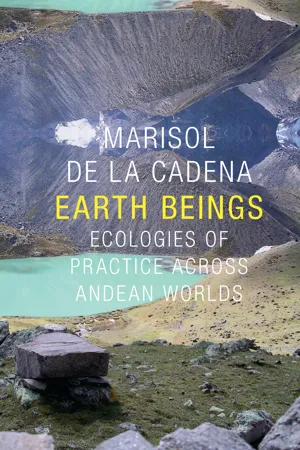
- English
- PDF
- Available on iOS & Android
eBook - PDF
About this book
Earth Beings is the fruit of Marisol de la Cadena's decade-long conversations with Mariano and Nazario Turpo, father and son, runakuna or Quechua people. Concerned with the mutual entanglements of indigenous and nonindigenous worlds, and the partial connections between them, de la Cadena presents how the Turpos' indigenous ways of knowing and being include and exceed modern and nonmodern practices. Her discussion of indigenous political strategies—a realm that need not abide by binary logics—reconfigures how to think about and question modern politics, while pushing her readers to think beyond "hybridity" and toward translation, communication that accepts incommensurability, and mutual difference as conditions for ethnography to work.
Frequently asked questions
Yes, you can cancel anytime from the Subscription tab in your account settings on the Perlego website. Your subscription will stay active until the end of your current billing period. Learn how to cancel your subscription.
No, books cannot be downloaded as external files, such as PDFs, for use outside of Perlego. However, you can download books within the Perlego app for offline reading on mobile or tablet. Learn more here.
Perlego offers two plans: Essential and Complete
- Essential is ideal for learners and professionals who enjoy exploring a wide range of subjects. Access the Essential Library with 800,000+ trusted titles and best-sellers across business, personal growth, and the humanities. Includes unlimited reading time and Standard Read Aloud voice.
- Complete: Perfect for advanced learners and researchers needing full, unrestricted access. Unlock 1.4M+ books across hundreds of subjects, including academic and specialized titles. The Complete Plan also includes advanced features like Premium Read Aloud and Research Assistant.
We are an online textbook subscription service, where you can get access to an entire online library for less than the price of a single book per month. With over 1 million books across 1000+ topics, we’ve got you covered! Learn more here.
Look out for the read-aloud symbol on your next book to see if you can listen to it. The read-aloud tool reads text aloud for you, highlighting the text as it is being read. You can pause it, speed it up and slow it down. Learn more here.
Yes! You can use the Perlego app on both iOS or Android devices to read anytime, anywhere — even offline. Perfect for commutes or when you’re on the go.
Please note we cannot support devices running on iOS 13 and Android 7 or earlier. Learn more about using the app.
Please note we cannot support devices running on iOS 13 and Android 7 or earlier. Learn more about using the app.
Yes, you can access Earth Beings by Marisol de la Cadena in PDF and/or ePUB format, as well as other popular books in Social Sciences & Latin American & Caribbean History. We have over one million books available in our catalogue for you to explore.
Information
Publisher
Duke University Press BooksYear
2015Print ISBN
9780822359630, 9780822359449eBook ISBN
97808223752652
S
T
O
R
Y
1
lation
and
my
practice
of
anthropology
in
Cuzco,
and
that
of
Carmona
and
Flores
Ochoa
in
the
same
region.
I
was
born
in
Lima.
Quechua
is
not
my
na-
tive
language,
and
my
proficiency
is
weak.
In
contrast,
Carmona
and
Flores
Ochoa
were
born
in
the
southern
Andes
of
Peru
and
are
native
speakers
of
both
Quechua
and
Spanish.
When
they
interacted
with
Nazario—whether
as
anthropologists
or
as
friends—they
did
not
need
translation.
However,
the
Turpos
and
I
could
not
avoid
it.
Articulated
at
the
intersection
of
dis-
ciplinary
practice
and
regional
belonging,
this
difference—and
not
only
my
theoretical
views—made
translation
a
very
tangible
feature
in
my
rela-
tionship
with
Mariano
and
Nazario.
rough
our
conversations
we
worked
together
to
understand
each
other,
co-laboring
through
linguistic
and
con-
ceptual
hurdles,
assisted
by
many
intermediaries,
particularly
Elizabeth
Ma-
mani.3
Our
joint
labor
created
the
conversations
that
we
could
consider
“the
original”
for
this
book.
us
it
was
not
Nazario’s
or
Mariano’s
cultural
text
that
I
translated.
Instead,
the
original—which,
I
repeat,
consisted
of
our
con-
Aurelio
Carmona,
Nazario
Turpo,
and
Jorge
Flores
Ochoa
at
the
inauguration
of
the
National
Museum
of
the
American
Indian,
Washington
D.C.,
September
2004.
Table of contents
- Contents
- Foreword
- Preface: Ending This Book without Nazario Turpo
- Story 1: Agreeing to Remember, Translating, and Carefully Co-Laboring
- Interlude 1: Mariano Turpo: A Leader In-Ayllu
- Story 2: Mariano Engages “The Land Struggle”: An Unthinkable Indian Leader
- Story 3: Mariano’s Cosmopolitics: Between Lawyers and Ausangate
- Story 4: Mariano’s Archive: The Eventfulness of the Ahistorical
- Interlude 2: Nazario Turpo: “The Altomisayoq Who Touched Heaven”
- Story 5: Chamanismo Andino in the Third Millennium: Multiculturalism Meets Earth-Beings
- Story 6: A Comedy of Equivocations: Nazario Turpo’s Collaboration with the National Museum of the American Indian
- Story 7: Munayniyuq: The Owner of the Will (and How to Control That Will)
- Epilogue: Ethnographic Cosmopolitics
- Acknowledgments
- Notes
- References
- Index